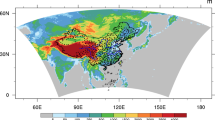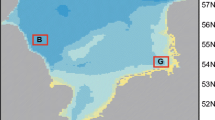Abstract
In this study, future changes in regional extreme wave heights around the Korean Peninsula are projected by using the results of an atmosphere general circulation model and a third-generation wave model. The direct use of the model output at each grid point is not appropriate even though high resolution of 20 km is used for the models. Therefore, the model output is grouped into six regions around the Korean Peninsula. The grouping approach is reasonable in assessing climate change effects with alleviated model uncertainty. The extreme wave heights are simulated for two climate periods of 1979–2003 (present climate) and 2075–2099 (future climate). The model results are validated by comparing the simulated wave heights for the present climate with observed and hindcasted wave data. The extreme wave heights for the future climate are then projected for different seasons and in different regions. The 50-year return wave height in summer is projected to increase in most regions, especially in the high-latitude Yellow Sea and the East Sea, while the wave height in winter is projected to decrease in all the regions, especially in the East Sea.
Similar content being viewed by others
References
Booij N, Ris R, Holthuijsen L (1999) A third-generation wave model for coastal regions: I-Model description and validation. J Geophys Res 104(C4):7649–7666
Coles S (2001) An introduction to statistical modeling of extreme values. Springer, London, 224 p
Debernard J, Saetra O, Roed LP (2002) Future wind, wave and storm surge climate in the northern North Atlantic. Clim Res 23:39–49
Gilleland E, Katz R, Young G (2004) extRemes. R package version 1.63. http://www.r-project.org
Goda Y (2010) Random seas and design of maritime structures (3rd ed). World Scientific, Singapore, 732 p
Goda Y, Konagaya O, Takeshita N, Hitomi H, Nagai T (2000) Population distribution of extreme wave heights estimated through regional analysis. In: Proceedings of 27th Intetnational Conference on Coastal Engineering, Sydney, pp 1078–1091
Goda Y, Kudaka M, Kawai H (2010) Incorporation of Weibull distribution in L-moments method for regional frequency analysis of peak-over-threshold wave heights. In: Proceedings of 32nd International Conference on Coastal Engineering, Shanghai.
Hasselmann K, Ewing JA (1979) A hybrid parametrical wave prediction model. J Geophys Res 84:5727–5738
Hemer MA, Wang XL, Church JA, Swail VR (2010) Modeling proposal: Coordinating global ocean wave climate projections. B Am Meteorol Soc 91:451–454
Hemer MA, Katzfey J, Trenham C (2013a) Global dynamical projections of surface ocean wave climate for a future high greenhouse gas emission scenario. Ocean Model 70:221–245. doi: 10.1016/j.ocemod.2012.09.008
Hemer MA, Fan Y, Mori N, Semedo A, Wang XL (2013b) Projected changes in wave climate from a multi-model ensemble. Nature Climate Change, 6p, doi:10.1038/nclimate1791
Hosking JRM, Wallis JR (1997) Regional frequency analysis: An approach based on L-moments. Cambridge University Press, Cambridge, UK, 244 p
IPCC (2007) Climate Change 2007: The physical science basis. Cambridge university Press, Cambridge, UK, 996 p
Kim JH, Ho CH, Lee MH, Jeong JH, Chen D (2006) Large increase in heavy rainfall associated with tropical cyclone landfalls in Korea after the late 1970s. Geophys Res Lett 33:L18706
Kim SY, Yasuda T, Mase H, Matsumi Y (2013) Storm surge simulations based on climate change projection data along the Korean coast. In: Proceedings of 2013 Joint Conference on Korean Association of Ocean Science and Technology Societies, Jeju, Korea, pp 1619–1622
Kitoh A, Ose T, Kurihara K, Kusunoki S, Sugi M (2009) Projection of changes in future weather extremes using super-high-resolution global and regional atmospheric models in the Kakushin. Kakushin Team-3 Modeling Group
KORDI (2005) Report on the deep sea design wave estimation for sea adjacent to Korea. KORDI, BSPE95100-1735-2 (in Korean)
Lee DY, Jun KC (2006) Estimation of design wave height for the waters around the Korean Peninsula. Ocean Sci J 41:245–254
Lim D-U (2013) Projection of change of extreme wave heights around Korean Peninsula due to climate change. M.S. Thesis, Seoul National University, 116 p
Mori N, Yasuda T, Mase H, Tom T, Oku Y (2010) Projection of extreme wave climate change under global warming. Hydrol Res Lett 4:15–19
Mori N, Shimura T, Yasuda T, Mase H (2013) Multi-model climate projections of ocean surface variables under different climate scenarios-Future change of waves, sea level and wind. Ocean Eng 71(1):122–129. doi: 10.1016/j.oceaneng.2013.02.016
Murakami H, Wang Y, Yoshimura H, Mizuta R, Sugi M, Shindo E, Adachi Y, Yukimoto S, Hosaka M, Kusunoki, S, Ose T, Kitoh A (2012) Future change in tropical cyclone activity projected by the new high-resolution MRI-AGCM. J Climate 25:3237–3260
Oh SM, Moon I-J (2013) Typhoon and storm surge intensity changes in a warming climate around the Korean Peninsula. Nat Hazards 66:1405–1429
R Development Core Team (2008) R: A language and environment for statistical computing. R Foundation for Statistical Computing, Vienna, Austria, http://www.R-project.org.
Shimura T, Mori N, Nakajo S, Yasuda T, Mase H (2011). Extreme wave climate change projection at the end of 21st century. In: Proceedings of 6th International Conference on Asian and Pacific Coasts, Hong Kong, pp 341–348
Tompson EF, Cardon VJ (1996) Practical modeling of hurricane surface wind fields. J Waterway Port Coastal Ocean Eng 122(4):195–205
Van Gelder PHAJM, Voortman HG, Vrijling JK (1999) Estimation techniques for inhomogeneous hydraulic boundary conditions along coast lines with a case study to the Dutch Petten Sea Dike. In: Balkema AA (ed) Applications of Statistics and Probablity, pp 1205–1212
Viglione A, Laio F, Claps P (2007) A comparison of homogeneity tests for regional frequency analysis. Water Resour Res 43: W03428. doi: 10.1029/2006WR005095
WAMDI Group (1988) The WAM model-a third generation ocean wave prediction model. J Phys Oceanogr 18:1775–1810
Wang XL, Swail VR (2006) Climate change signal and uncertainty in projections of ocean wave heights. Clim Dynam 26:109–126
Author information
Authors and Affiliations
Corresponding author
Rights and permissions
About this article
Cite this article
Lim, DU., Suh, KD. & Mori, N. Regional projection of future extreme wave heights around Korean Peninsula. Ocean Sci. J. 48, 439–453 (2013). https://doi.org/10.1007/s12601-013-0037-7
Received:
Revised:
Accepted:
Published:
Issue Date:
DOI: https://doi.org/10.1007/s12601-013-0037-7




